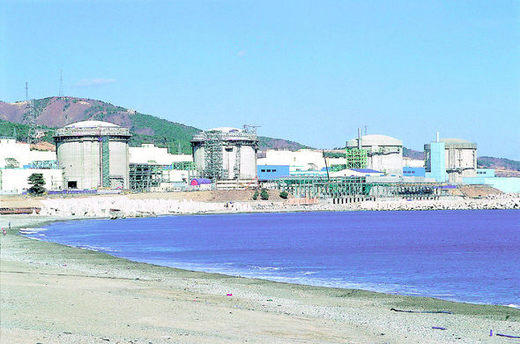Posted on : Sep.4,2006 14:04 KST
Modified on : Sep.5,2006 14:26 KST
Activists say move is meant to extend life of plant beyond current date
Korea Hydro & Nuclear Power Co. has launched its plans to replace aging parts of a nuclear generator that is facing a shutdown. The operator argues that it is an inevitable move for safety reasons, but suspicions are mounting that the move is intended to extend the power plant’s lifetime amid safety concerns. The plant is currently set to be shut down in 2012.
According to sources, South Korea’s nuclear power operator signed a contract in March with a Canadian company to replace pressure tubes on one of its power plants located in Wolsung. The deal with the Atomic Energy of Canada Ltd. (AECL) was estimated at around 300 billion won (US$308 million), the sources said.
A pressure tube is a key component in the cooling process during nuclear power generation.
The KHNP said it was taking the measures to guarantee safety. "The Wolsung No. 1 generator has [shown signs of] deterioration, as it was used more frequently than the other generators. So we made the decision to replace the key component," a KHNP spokesman said.
But an official of the Canadian company said that replacing the pressure tubes is tantamount to building a brand new power plant.
Seok Kwang-hoon, an official of Green Korea, a civic environmental group, said, "Once much money is poured into replacing parts, it would be almost impossible to veto an extension of the plant’s lifetime at a later date."
The government has plans to request an extension on the lifetime of the Wolsung No. 1 generator, whose operation is currently slated to end in 2012, according to an expert in the field who has seen KHNP plans for such an extension.
Seok said that in other countries such as the U.S., the process of extending the lifetime of a nuclear generator is subject to strict deliberation because of the safety issues involved.
Suspicions are mounting that the KHNP is attempting to avoid outcry from civic and environmental groups for its alleged attempt to renew the lifetime of the nuclear generator.
"If [KHNP] fails to draw trust from people, it would be tough to persuade the public to agree to an extension," said Yun Sun-jin, a professor of graduate school of environmental studies at Seoul National University. "What is important is dialogue and transparency in procedures."
The government has already spent more than 100 billion won to replace components of a nuclear generator located in Gori, which was followed by a workshop held August 31 by the Electrical Engineering and Science Research Institute at Seoul National University to help determine whether the lifespan of the generator should be extended. The generator, Gori No. 1, the first power plant in South Korea, saw almost all its components replaced except for the core reactors.

